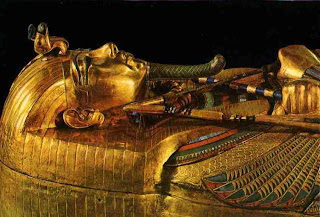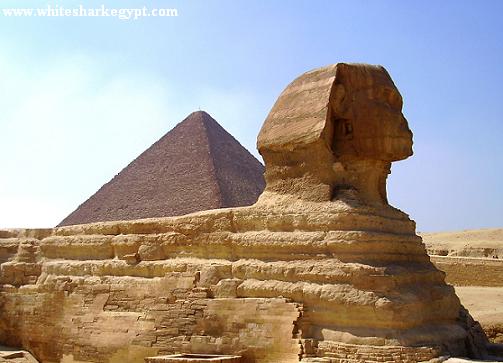Today is National Tutankhamun Day, and we will therefore invite you to learn about his history
Tutankhamun was an Egyptian pharaoh of the 18th dynasty (ruled ca. 1332 BC – 1323 BC), during the New Kingdom. Tutankhamun was the son of Akhen
aten
(Amenhotep IV) and one of Akhenaten's sisters. As a prince he was known
as Tutankhaten. He ascended to the throne around 1333 BC. When he
became king, he married his half-sister, Ankhesenpaaten, who later
changed her name to Ankhesenamun. They had two daughters, both
stillborn.
Given his age, the king probably had very powerful advisers, presumably including General Horemheb, the Vizier Ay, and Maya, the "Overseer of the Treasury". They probably also advised him to go back to the old gods, and in his third regnal year, Tutankhamun reversed several changes made during his father's reign. He ended the worship of the god Aten and restored the god Amun to supremacy. The ban on the cult of Amun was lifted and traditional privileges were restored to its priesthood. The capital was moved back to Thebes and the city of Akhetaten abandoned. This is also when he changed his name to Tutankhamun.
As part of his restoration, the king initiated building projects, in particular at Thebes and Karnak, where he dedicated a temple to Amun. Many monuments were erected, and an inscription on his tomb door declares the king had "spent his life in fashioning the images of the gods". The traditional festivals were now celebrated again, including those related to the Apis Bull, Horemakhet, and Opet.
There are no surviving records of Tutankhamun's final days. Major studies have been conducted in an effort to establish the cause of death. Several theories have been put forth; one was that he was killed by a blow to the head, while another was that his death was caused by a broken leg.
Research conducted in 2005 found that he was not killed by a blow to the head. However they did show that he had badly broken his leg shortly before his death, and that the leg had become infected. Images also discovered congenital flaws, which are more common among the children of incest. It is suspected he also had a partially cleft palate, another congenital defect. As Tutankhamun was the result of an incestuous relationship and, he may have suffered from several other genetic defects that contributed to his early death.
DNA analysis conducted in 2010 showed the presence of malaria in his system. From this it is believed that an infection or other genetic defects combined with malaria led to his death.
With the death of Tutankhamun and the two stillborn children buried with him, the Thutmosid family line came to an end. The Amarna letters indicate that Tutankhamun's wife, recently widowed, wrote to the Hittite king Suppiluliuma I, asking if she could marry one of his sons. The letters do not say how Tutankhamun died. In the message to the Hittite king, Ankhesenamun says that she was very afraid, but would not take one of her own people as husband. However, the son was killed before reaching his new wife. Shortly afterward Ay married Tutankhamun's widow and became Pharaoh as a war between the two countries was fought, and Egypt was left defeated. The fate of Ankhesenamun is not known, but she disappears from record and Ay's second wife Tey became Great Royal Wife. After Ay's death, Horemheb usurped the throne and instigated a campaign of damnatio memoriae against him. Tutankhamun's father Akhenaten, stepmother Nefertiti, his wife Ankhesenamun, half sisters and other family members were also included. Not even Tutankhamun was spared. His images and cartouches were also erased. Horemheb himself was left childless and willed the throne to Paramessu, who founded the Ramesside family line of pharaohs.
Tutankhamun was buried in a tomb that was small relative to his status. His death may have occurred unexpectedly, before the completion of a grander royal tomb, so that his mummy was buried in a tomb intended for someone else. This would preserve the observance of the customary seventy days between death and burial.
King Tutankhamun's mummy still rests in his tomb in the Valley of the Kings. On 4 November 2007, 85 years to the day after Carter's discovery, the 19-year-old pharaoh went on display in his underground tomb at Luxor, when the linen-wrapped mummy was removed from its golden sarcophagus to a climate-controlled glass box. The case was designed to prevent the heightened rate of decomposition caused by the humidity and warmth from tourists visiting the tomb.
Inside the tomb of King Tutankhamun was a large collection of artifacts used throughout the King’s life, which you can visit now in the Egyptian Museum in Cairo. These artifacts ranged from a decorated chest, which was most likely used as a closet or suitcase, two ivory and gold bracelets, necklaces, and other decorative jewelry, to alabaster vases and flasks. The tomb was also home to many weapons and instruments used by the King. Although the tomb held over 3,500 artifacts, the tomb was not found completely intact. In fact, there had been at least two robberies of the tomb, perhaps soon after Tutankhamun's burial.
The best known artifact in King Tutankhamun’s tomb is the famous Gold Mask, which rested over the bandages that were wrapped around the King’s face. The mask weighs in at 11 kg (24.5 pounds) of solid gold, and is believed to represent what the King’s face really looked like.
Given his age, the king probably had very powerful advisers, presumably including General Horemheb, the Vizier Ay, and Maya, the "Overseer of the Treasury". They probably also advised him to go back to the old gods, and in his third regnal year, Tutankhamun reversed several changes made during his father's reign. He ended the worship of the god Aten and restored the god Amun to supremacy. The ban on the cult of Amun was lifted and traditional privileges were restored to its priesthood. The capital was moved back to Thebes and the city of Akhetaten abandoned. This is also when he changed his name to Tutankhamun.
As part of his restoration, the king initiated building projects, in particular at Thebes and Karnak, where he dedicated a temple to Amun. Many monuments were erected, and an inscription on his tomb door declares the king had "spent his life in fashioning the images of the gods". The traditional festivals were now celebrated again, including those related to the Apis Bull, Horemakhet, and Opet.
There are no surviving records of Tutankhamun's final days. Major studies have been conducted in an effort to establish the cause of death. Several theories have been put forth; one was that he was killed by a blow to the head, while another was that his death was caused by a broken leg.
Research conducted in 2005 found that he was not killed by a blow to the head. However they did show that he had badly broken his leg shortly before his death, and that the leg had become infected. Images also discovered congenital flaws, which are more common among the children of incest. It is suspected he also had a partially cleft palate, another congenital defect. As Tutankhamun was the result of an incestuous relationship and, he may have suffered from several other genetic defects that contributed to his early death.
DNA analysis conducted in 2010 showed the presence of malaria in his system. From this it is believed that an infection or other genetic defects combined with malaria led to his death.
With the death of Tutankhamun and the two stillborn children buried with him, the Thutmosid family line came to an end. The Amarna letters indicate that Tutankhamun's wife, recently widowed, wrote to the Hittite king Suppiluliuma I, asking if she could marry one of his sons. The letters do not say how Tutankhamun died. In the message to the Hittite king, Ankhesenamun says that she was very afraid, but would not take one of her own people as husband. However, the son was killed before reaching his new wife. Shortly afterward Ay married Tutankhamun's widow and became Pharaoh as a war between the two countries was fought, and Egypt was left defeated. The fate of Ankhesenamun is not known, but she disappears from record and Ay's second wife Tey became Great Royal Wife. After Ay's death, Horemheb usurped the throne and instigated a campaign of damnatio memoriae against him. Tutankhamun's father Akhenaten, stepmother Nefertiti, his wife Ankhesenamun, half sisters and other family members were also included. Not even Tutankhamun was spared. His images and cartouches were also erased. Horemheb himself was left childless and willed the throne to Paramessu, who founded the Ramesside family line of pharaohs.
Tutankhamun was buried in a tomb that was small relative to his status. His death may have occurred unexpectedly, before the completion of a grander royal tomb, so that his mummy was buried in a tomb intended for someone else. This would preserve the observance of the customary seventy days between death and burial.
King Tutankhamun's mummy still rests in his tomb in the Valley of the Kings. On 4 November 2007, 85 years to the day after Carter's discovery, the 19-year-old pharaoh went on display in his underground tomb at Luxor, when the linen-wrapped mummy was removed from its golden sarcophagus to a climate-controlled glass box. The case was designed to prevent the heightened rate of decomposition caused by the humidity and warmth from tourists visiting the tomb.
Inside the tomb of King Tutankhamun was a large collection of artifacts used throughout the King’s life, which you can visit now in the Egyptian Museum in Cairo. These artifacts ranged from a decorated chest, which was most likely used as a closet or suitcase, two ivory and gold bracelets, necklaces, and other decorative jewelry, to alabaster vases and flasks. The tomb was also home to many weapons and instruments used by the King. Although the tomb held over 3,500 artifacts, the tomb was not found completely intact. In fact, there had been at least two robberies of the tomb, perhaps soon after Tutankhamun's burial.
The best known artifact in King Tutankhamun’s tomb is the famous Gold Mask, which rested over the bandages that were wrapped around the King’s face. The mask weighs in at 11 kg (24.5 pounds) of solid gold, and is believed to represent what the King’s face really looked like.




Comments
Post a Comment